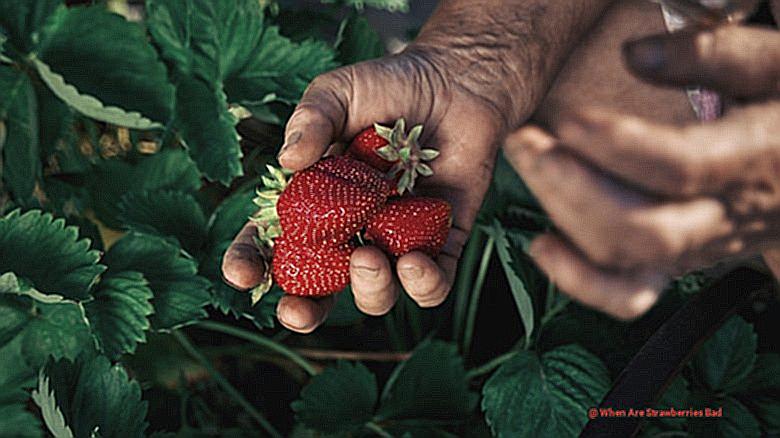Imagine a warm summer day, the sun shining down on you as you bite into a plump, juicy strawberry. The burst of sweetness and vibrant red color make it seem like the perfect snack. But what if I told you that these seemingly innocent berries can actually be harmful? That’s right, as much as we love them, there are certain circumstances when strawberries can pose a threat to our health.
Before we dive into when strawberries can be bad for us, let’s establish some background information. Strawberries are one of the most beloved fruits in the world, known for their delicious taste and versatility in dishes. However, they also hold the title of being one of the most allergenic fruits out there.
Allergic reactions to strawberries can range from mild symptoms such as itching and hives to more severe ones like difficulty breathing and anaphylaxis. In fact, studies have shown that strawberry allergies are becoming increasingly common among children and adults alike.

But it’s not just allergies that we need to be cautious of when it comes to strawberries. The proteins found in these berries can also trigger oral allergy syndrome, causing tingling or swelling in the mouth and throat. This is especially important for those with pollen allergies as they may experience cross-reactivity between certain types of plant proteins.
Furthermore, pesticides used in strawberry farming have been linked to various health issues such as cancer and hormone disruption. These chemicals are used to protect the crops from pests but can also harm human health if consumed in large amounts or over a long period of time.
Lastly, strawberries are high in oxalates – compounds that bind with calcium – which can contribute to kidney stone formation for those with a history of calcium oxalate stones.
While this doesn’t mean you should completely avoid strawberries if you’re prone to kidney stones, it’s important to consume them in moderation and consult with your doctor about any concerns.
While strawberries may seem like the perfect summer treat, it’s important to be aware of these potential risks. As with any food, moderation is key and always listen to your body’s reactions.
Contents
- 1 How Long Do Strawberries Last
- 2 How To Tell If Strawberries Are Bad?
- 3 How To Store Strawberries
- 3.1 Keep them whole
- 3.2 Keep them dry
- 3.3 Keep them spaced out (if possible)
- 3.4 Keep them in the fridge
- 3.5 Keep them covered/in high humidity
- 3.6 In summary, following these storage methods will help ensure that your strawberries stay firm and fresh for up to a week in the fridge. However, it’s important to check daily for moldy or crushed berries and discard any heavily punctured or green ones.
- 4 How To Freeze Strawberries
- 5 Rotten Records: Share Your Snap.
- 6 Conclusion
How Long Do Strawberries Last
Strawberries can spoil if not correctly stored or handled. There are several indications that strawberries have gone bad, including:
- Mold growing: If you see fuzzy patches on your strawberries’ surface, white or grey in color, it is a clear sign that they have spoiled. Mold can rapidly spread, ruining the entire batch, so it is best to dispose of them immediately.
- Discoloration: Fresh strawberries should be bright red with no dark or black spots. Any discoloration indicates that the fruit is starting to spoil.
- Softness or mushiness: Strawberries should have a firm texture and feel slightly soft when touched. If they feel too soft, squishy, or mushy, it is a sign that they have gone bad.
- Unpleasant taste or smell: If your strawberries have an unusual taste or smell, it is a strong indication that they have spoiled. Trust your senses and avoid consuming them.
- White or grey fuzz: Similar to mold growth, white or grey fuzz on strawberries means that they are no longer safe to eat.
To ensure your strawberries’ safety, always store them properly in the refrigerator. Avoid washing them until just before eating to prevent excess moisture and spoilage. When selecting strawberries, look for ones that are firm, uniformly red, and free of any mold. If you notice any heavily punctured or green patches on your strawberries, discard them immediately.
Strawberries can spoil due to improper storage or handling. It is essential to check for signs of spoilage before consuming them.
How To Tell If Strawberries Are Bad?
When you want to know if strawberries are no longer good, watch out for these signs:
Mold growth
If you see any fuzzy, white or grey mold on the surface of the strawberries, it’s a definite sign that they have gone bad and should be thrown away.
Discoloration
Any brown or black spots on the strawberries indicate that they are past their prime and should not be eaten.
Softness, squishiness, or mushiness
Strawberries should feel firm when touched. If they feel soft, squishy, or mushy, it means they have started to go bad.
Unpleasant taste or smell
If your strawberries have a strange or unpleasant smell, or if they taste sour or off, it’s a sign that they have gone bad and should not be consumed.
White or grey fuzz on the surface
This is another type of mold that can grow on strawberries and indicates that they are no longer safe to eat.
When checking for these signs, make sure to examine all sides of the strawberry, as spoilage can sometimes hide on one side. It’s also important to note that strawberries should only be washed right before eating, as any excess moisture can cause them to spoil quicker. Additionally, when storing strawberries in the fridge, always check for moldy or crushed ones daily and discard them immediately.
To keep your strawberries fresh and extend their shelf life, follow these tips:
Keep them in the refrigerator
Strawberries should be refrigerated for maximum freshness. They can last up to 7 days in the fridge, but be sure to check for moldy or crushed ones daily.
Choose fresh strawberries
When selecting strawberries, look for ones that are evenly red, firm, and free of mold.
Freeze them

If you wish to keep your strawberries for longer periods of time, they can also be successfully frozen. Simply wash, remove stems, and cut them into 2-4 inch lengths before placing them in freezer bags and removing all air.
How To Store Strawberries
When it comes to storing strawberries to prevent them from spoiling, there are a few key methods you can follow to keep them fresh for as long as possible. These simple steps will help ensure that your strawberries stay firm and flavorful:
Keep them whole
First and foremost, it’s important to store your strawberries whole. Avoid cutting them into pieces as this exposes more surface area and makes them more prone to spoilage.
Keep them dry
Before storing your strawberries, make sure they are completely dry. Washing them before storage can cause excess moisture, leading to mushiness and quick spoilage. To keep them dry, place a few paper towels or a clean kitchen towel on a plate, baking sheet, or shallow glass bowl and place the strawberries on top.
Keep them spaced out (if possible)
If you have the space, try to avoid stacking your strawberries on top of each other. This will prevent any crushing or bruising of the berries and allow for better air circulation.
Keep them in the fridge
The best place to store strawberries is in the crisper drawer of your fridge. The cold temperature will slow down the ripening process and inhibit mold growth.
Keep them covered/in high humidity
To maintain freshness, cover your strawberries with plastic wrap or place them in an airtight container. This will also help maintain high humidity levels, important for preventing mold growth.
In summary, following these storage methods will help ensure that your strawberries stay firm and fresh for up to a week in the fridge. However, it’s important to check daily for moldy or crushed berries and discard any heavily punctured or green ones.
Properly storing strawberries not only keeps them fresh but also maintains their delicious flavor. By keeping them whole, dry, spaced out, refrigerated, and covered, you can enjoy these juicy fruits for longer.
How To Freeze Strawberries
For those looking to preserve the freshness and safety of their strawberries, freezing them is the best option. To ensure that your frozen strawberries are at their optimal quality, follow these steps:
- Step 1: Choose fully ripe and blemish-free strawberries for freezing.
- Step 2: Thoroughly wash and dry the strawberries before freezing.
- Step 3: Utilize the tray freeze method by placing the strawberries in a single layer on a tray and freezing them before transferring to a freezer-safe container. This technique reduces ice crystal formation and helps maintain the shape and texture of the strawberries.
- Step 4: Store the frozen strawberries at a temperature of 0°F or below to prevent the growth of harmful bacteria.
- Step 5: Properly seal the container or freezer bag to prevent air from entering and causing freezer burn.
- Step 6: Label the container with the date of freezing and consume within six months for optimal quality.
Following these steps will guarantee that your frozen strawberries remain fresh, safe to eat, and retain their delicious flavor and texture. It is also important to regularly check the temperature of your freezer and consume the strawberries within six months for best results.
Strawberries are a delectable and nutritious fruit that can add a burst of flavor to any dish. However, like all food, they can spoil if not stored and handled correctly. Being aware of the typical indications of spoiled strawberries can help individuals identify when they are no longer fit for consumption.
White fuzz, brown spots, and mushy texture
The first sign of spoiled strawberries is the growth of white fuzz or mold on the berries. This is caused by the development of yeast and bacteria, which can occur due to exposure to air or moisture. Additionally, brown spots on the berries may suggest that they are past their prime and beginning to decay. The texture of spoiled strawberries also tends to be mushy and soft instead of firm.
Alcoholic or foul smell
Spoiled strawberries may also emit a strong alcoholic or foul smell, similar to vinegar or nail polish remover. This is due to the fermentation process that takes place when bacteria break down the sugars in the berries, producing alcohol and other compounds that release an unpleasant odor.
Bruising and leaking juice
If you notice any bruises on your strawberries or if they are leaking juice, it could be an indication that they are starting to spoil. Bruised or damaged berries are more susceptible to bacterial growth, which can cause them to spoil at a faster rate.
Discoloration and loss of firmness
Spoiled strawberries may also begin to lose their vibrant red color and become dark or discolored. They may also lose their firmness and become soft and squishy.
Mold growth, particularly under the calyx
The growth of mold is a clear indicator that strawberries have spoiled. It can appear as white or green fuzzy spots on the surface of the berries, especially under the calyx (the green leaves at the top of the berry). If you spot any mold on your strawberries, it’s best to discard them immediately.
Unpleasant taste or lack of flavor
Spoiled strawberries may have a sour, bitter, or off taste, or they may lack the sweet and juicy flavor that fresh strawberries are known for. This is due to the breakdown of sugars and other compounds in the berries as they spoil.
Presence of fruit flies or other bugs feasting on the strawberries
Fruit flies and other insects are attracted to the sweet scent of ripe strawberries. If you notice an infestation of these pests around your strawberries, it could be a sign that they are beginning to spoil and should be thrown away.
By remaining vigilant for these common signs of spoiled strawberries, individuals can determine when their berries are no longer safe to eat.
Conclusion
In conclusion, strawberries may be a popular summer treat, but they can also have negative effects on our health.
Allergies, pesticides, and high levels of oxalates can be harmful to certain individuals. It is crucial to be aware of these risks and consume strawberries in moderation.
By paying attention to signs of spoiled strawberries, we can ensure that we always enjoy them at their peak.




